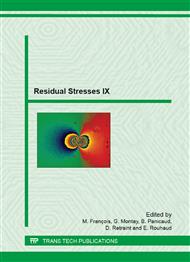[1]
S. Suresh: Failure of Materials, Cambridge University Press; 2nd edition, November 28, (1998).
Google Scholar
[2]
J.Y. Yung and F.V. Lawrence: Analytical and Graphical Aids for the Fatigue Design of Weldments, Fatigue and Fracture of Engineering Materials and Structures, Vol. 8, No. 3, pp.223-241, (1985).
DOI: 10.1111/j.1460-2695.1985.tb00424.x
Google Scholar
[3]
Yung, J.Y. and F.V. Lawrence: Estimating the Effects of Residual Stress on the Fatigue Life of Notched Components, University of Illinois, Materials Engineering Report No. 124, (1986).
Google Scholar
[4]
M. Chiarelli, A. Lanciotti and M. Sacchi: Fatigue resistance of MAG welded steel elements, International Journal of Fatigue, 21(10), 1099-1110, (1999).
DOI: 10.1016/s0142-1123(99)00080-8
Google Scholar
[5]
G.A. Webster and A.N. Ezeilo: Residual stress distributions and their influence on fatigue lifetimes, International Journal of Fatigue, 23, suppl. 1, 375-383, (2001).
DOI: 10.1016/s0142-1123(01)00133-5
Google Scholar
[6]
J. Lu: Handbook of Measurement of Residual Stresses, Society For Experimental Mechanics, Lilburn, GA, (1996).
Google Scholar
[7]
N. Ganev, I. Kraus: On the application of X-ray tensometry to states of stress due to tangential machining of metal surfaces, Phys. Stat. Sol. (a), 106, 467-472, (1988).
DOI: 10.1002/pssa.2211060217
Google Scholar
[8]
R.C. McClung: A literature survey on the stability and significance of residual stresses during fatigue, Fatigue Fract Engng Mater Struct 30, 173-205, (2007).
DOI: 10.1111/j.1460-2695.2007.01102.x
Google Scholar
[9]
Z. Qian, L.S. Chumbley, T. Karakulak, E. Johnson: The residual stress relaxation behavior of weldments during cyclic loading, Metallurgical and Materials Transactions A, Vol. 44, Issue 7, 3147-3156, (2013).
DOI: 10.1007/s11661-013-1688-9
Google Scholar
[10]
M.T. Hutchings, P.J. Withers, T.M. Holden, T. Lorentzen: Introduction to the Characterization of Residual Stress by Neutron Diffraction, Taylor& Francis Group, Boca Raton, FL, (2005).
DOI: 10.1201/9780203402818
Google Scholar
[11]
I.C. Noyan and J.B. Cohen: Residual Stress: Measurement by Diffraction and Interpretation, Springer-Verlag, New York, (1987).
Google Scholar
[12]
M.B. Prime: Cross-Sectional Mapping of Residual Stresses by Measuring the Surface Contour After a Cut, Transactions of the ASME, Vol. 123, April (2001).
DOI: 10.1115/1.1345526
Google Scholar
[13]
M.R. Hill: Modeling of Residual Stress Effects Using Eigenstrain, 10th International Conference on Facture, Oahu, Hawaii, (2001).
Google Scholar
[14]
A.T. DeWald, M.R. Hill: Multi-Axial Contour Method for Mapping Residual Stresses in Continuously Processed Bodies, Experimental Mechanics 46: 473-490, (2006).
DOI: 10.1007/s11340-006-8446-5
Google Scholar
[15]
C.D.M. Liljedahl, O. Zanellato, M.E. Fitzpatrick, J. Lin, L. Edwards: The effect of weld residual stresses and their re-distribution with crack growth during fatigue under constant amplitude loading, International Journal of Fatigue 32: 735-743, (2010).
DOI: 10.1016/j.ijfatigue.2009.10.012
Google Scholar
[16]
Y. Zhang, S. Ganguly, L. Edwards, M.E. Fitzpatrick: Cross-sectional mapping of residual stresses in a VPPA weld using the contour method, Acta Materialia, 52: 5225-5232, (2004).
DOI: 10.1016/j.actamat.2004.07.045
Google Scholar
[17]
Z. Qian, L.S. Chumbley, E. Johnson: The effect of specimen dimension on residual stress relaxation of carburized and quenched steels, Materials Science and Engineering A, Vol. 529, 246-252, (2011).
DOI: 10.1016/j.msea.2011.09.024
Google Scholar
[18]
British Stainless Steel Association: Heat tint (temper) colours on stainless steel surfaces heated in air, www. bssa. org. uk.
Google Scholar
[19]
Baoping Bob He, Uwe Preckwinkel and Kingsley L. Smith: Fundamentals of Two-Dimensional X-ray Diffraction (XRD2), CPDS-International Center for Diffraction Data 2000, Advances in X-ray Analysis, Vol. 43.
Google Scholar
[20]
ASTM E915, Standard Test Method for Verifying the Alignment of X-Ray Diffraction Instrumentation for Residual Stress Measurement, ASTM International, West Conshohocken, PA, (2004).
DOI: 10.1520/e0915-16
Google Scholar
[21]
Y. Ueda: Sectioning Methods, in Handbook of Measurement of Residual Stresses, Society For Experimental Mechanics, Lilburn, GA, 5-34, (1996).
Google Scholar
[22]
Ansys version 12. 0, Ansys, Inc., Canonsburg, PA.
Google Scholar
[23]
Z. Qian, L.S. Chumbley, E. Johnson, work in progress.
Google Scholar
[24]
E. Johnson: Progress towards a model based approach to the robust design of welded structures, Ph. D Dissertation, (2013).
Google Scholar


